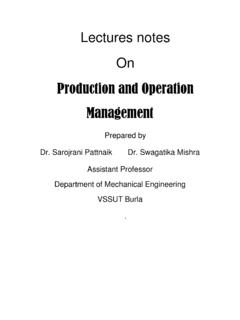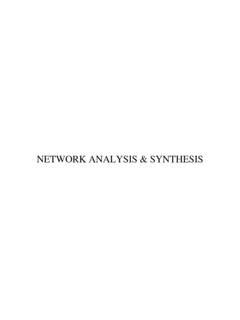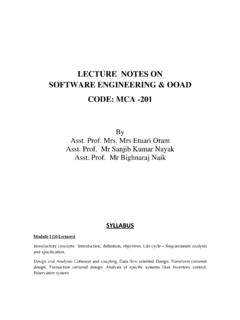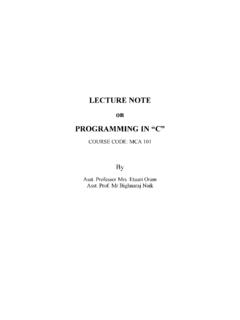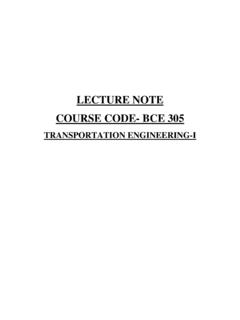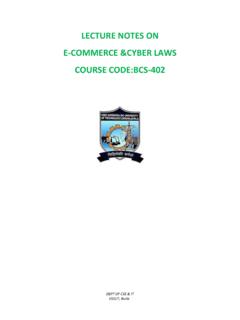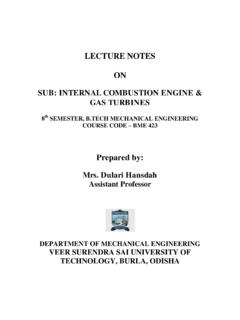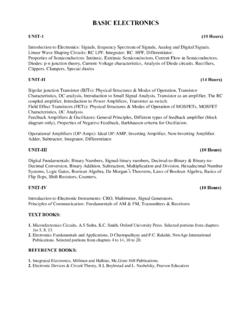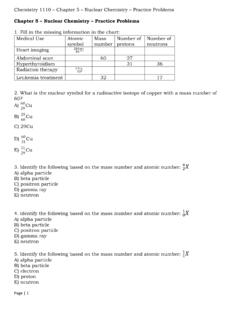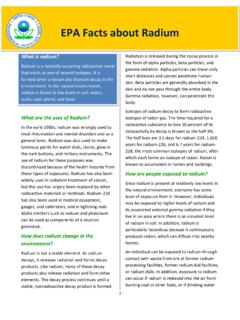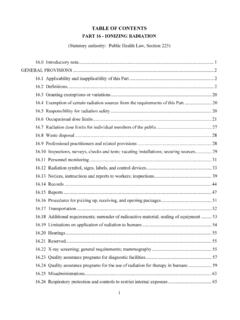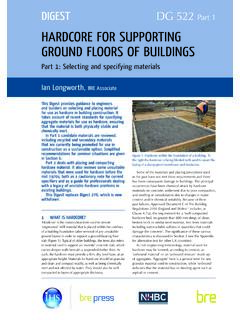Transcription of LECTURE NOTES ON ENVIRONMENTAL SCIENCE
1 LECTURE NOTES . ON. ENVIRONMENTAL SCIENCE . 3rd Semester (Chemistry). Subject code : CH-514. Prepared by Dr. Trinath Biswal Associate Professor, Chemistry Deptt. DISCLAIMER. This document does not claim any originality and cannot be used as a substitute for prescribed textbooks. The information presented here is merely a collection by the committee members for their respective teaching assignments. Various sources as mentioned at the end of the document as well as freely available material from internet were consulted for preparing this document. The ownership of the information lies with the author or institutions. MODULE -1. AIR POLLUTION (CHAPTER-1). Introduction: Air pollution refers to the release of pollutants into the air that are detrimental to human health and the planet as a whole.
2 The Clean Air Act authorizes the ENVIRONMENTAL Protection Agency (EPA) to protect public health by regulating the emissions of these harmful air pollutants. The NRDC has been a leading authority on this law since it was established in pollution is a change in the physical, chemical and biological characteristic of air that causes adverse effects on humans and other organisms. The ultimate result is a change in the natural environment and ecosystem. The substances that are responsible for causing air pollution are called air pollutants. These air pollutants can be either natural ( wildfires) or synthetic (man-made); they may be in the form of gas, liquid or solid. Types of Air Pollutants: An air pollutant is known as a substance in the air that can cause harm to humans and the environment.
3 Pollutants can be in the form of solid particles, liquid droplets, or gases. In addition, they may be natural or man-made. Pollutants can be classified as either primary or secondary. Usually, primary pollutants are substances directly emitted from a process, such as ash from a volcanic eruption, the carbon monoxide gas from a motor vehicle exhaust or sulphur dioxide released from factories. Secondary pollutants are not emitted directly. Rather, they form in the air when primary pollutants react or interact. An important example of a secondary pollutant is ground level ozone is one of the many secondary pollutants that causes photochemical smog. (1) Major primary pollutants produced by human activity Sulphur oxides (SOx): SO2 is produced by volcanoes and in various industrial processes.
4 Since coal and petroleum often contain sulphur compounds, their combustion generates sulphur dioxide. Further oxidation of SO2, usually in the presence of a catalyst such as NO2, forms H2SO4, and thus acid rain. This is one of the causes for concern over the ENVIRONMENTAL impact of the use of these fuels as power sources. ii. Nitrogen oxides (NOx): Especially nitrogen dioxide is emitted from high temperature combustion. Nitrogen dioxide is the chemical compound with the formula N0 2. It is responsible for photochemical smog, acid rain etc. iii. Carbon monoxide: It is a colourless, odourless, non-irritating but very poisonous gas. It is a product by incomplete combustion of fuel such as natural gas, coal or wood.
5 Vehicular exhaust is a major source of carbon monoxide. iv. Carbon dioxide (CO2): A greenhouse gas emitted from combustion but is also a gas vital to living organisms. It is a natural gas in the atmosphere. v. Volatile organic compounds: VOCs are an important outdoor air pollutant. In this field they are often divided into the separate categories of methane (CH4) and non-methane (NMVOCs). Methane is an extremely efficient greenhouse gas which contributes to enhanced global warming. Other hydrocarbon VOCs are also significant greenhouse gases via their role in creating ozone and in prolonging the life of methane in the atmosphere, although the effect varies depending on local air quality. Within the NMVOCs, the aromatic compounds benzene, toluene and xylene are suspected carcinogens and may lead to leukaemia through prolonged exposure.
6 1, 3-butadiene is another dangerous compound which is often associated with industrial uses. vi. Particulate matter: Particulates alternatively referred to as particulate matter (PM) or fine particles, are tiny particles of solid or liquid suspended in a gas. In contrast, aerosol refers to particles and the gas together. Sources of particulate matter can be manmade or natural. Some particulates occur naturally, originating from volcanoes, dust storms, forest and grassland fires, living vegetation, and sea spray. Human activities, such as the burning of fossil fuels in vehicles, power plants and various industrial processes also generate significant amounts of aerosols. Averaged over the globe, anthropogenic aerosols those made by human activities currently account for about 10 per cent of the total amount of aerosols in our atmosphere.
7 Increased levels of fine particles in the air are linked to health hazards such as heart disease, altered lung function and lung cancer. vii. Persistent free radicals connected to airborne fine particles could cause cardiopulmonary disease. viii. Toxic metals such as lead, cadmium and copper. ix. Chlorofluorocarbons (CFCs) harmful to the ozone layer emitted from products currently banned from use. x. Ammonia (NH3) emitted from agricultural processes. Ammonia is a compound with the formula NH3. It is normally encountered as a gas with a characteristic pungent odour. Ammonia contributes significantly to the nutritional needs of terrestrial organisms by serving as a precursor to foodstuffs and fertilizers.
8 Ammonia, either directly or indirectly, is also a building block for the synthesis of many pharmaceuticals. Although in wide use, ammonia is both caustic and hazardous. xi. Odours such as from garbage, sewage, and industrial processes xii. Radioactive pollutants produced by nuclear explosions, war explosives, and natural processes such as the radioactive decay of radon . Secondary pollutants include: i. Particulate matter formed from gaseous primary pollutants and compounds in photochemical smog. Smog is a kind of air pollution; the word smog is a portmanteau of smoke and fog. Classic smog results from large amounts of coal burning in an area caused by a mixture of smoke and sulphur dioxide. Modern smog does not usually come from coal but from vehicular and industrial emissions that are acted on in the atmosphere by sunlight to form secondary pollutants that also combine with the primary emissions to form photochemical smog.
9 Ii. Ground level ozone (O3) formed from NOx and VOCs. Ozone (O3) is a key constituent of the troposphere (it is also an important constituent of certain regions of the stratosphere commonly known as the Ozone layer). Photochemical and chemical reactions involving it drive many of the chemical processes that occur in the atmosphere by day and by night. At abnormally high concentrations brought about by human activities (largely the combustion of fossil fuel), it is a pollutant, and a constituent of smog. iii. Peroxyacetyl nitrate (PAN) similarly formed from NOx and VOCs and is a dangerous air pollutant mostly affects our respiratory system and nervous system. Sources of Air Pollution: Sources of air pollution refer to the various locations, activities or factors which are responsible for the releasing of pollutants in the atmosphere.
10 These sources can be classified into two major categories which are: sources (human activity). It mostly related to burning different kinds of fuel: i. Stationary Sources include smoke stacks of power plants, manufacturing facilities (factories) and waste incinerators, as well as furnaces and other types of fuel-burning heating devices. ii. Mobile Sources include motor vehicles, marine vessels, aircraft and the effect of sound etc. iii. Chemicals, dust and controlled burn practices in agriculture and forestry management. Controlled or prescribed burning is a technique sometimes used in forest management, farming, prairie restoration or greenhouse gas abatement. Fire is a natural part of both forest and grassland ecology and controlled fire can be a tool for foresters.
